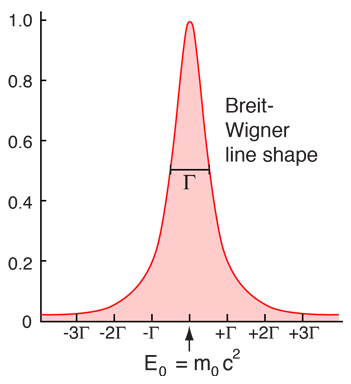Particle lifetimes from the uncertainty principle
 The Breit-Wigner distribution is similar to a gaussian near the peak, but the tails of the curve are flatter. |
The uncertainty principle provides a tool for characterizing the very short-lived products produced in high energy collisions in accelerators. The uncertainty principle in the form
 suggests that for particles with extremely short lifetimes, there will be a significant uncertainty in the measured energy. The measurment of the mass energy of an unstable particle a large number of times gives a distribution of energies called a Lorentzian or a Breit-Wigner distribution. |
If the width of this distribution at half-maximum is labeled Γ , then the uncertainty in energy ΔE could be reasonably expressed as

where the particle lifetime τ is taken as the uncertainty in time τ = Δt.
In high energy scattering experiments, the energy uncertainty ΔE can be determined and the lifetime implied from it. In other cases, the lifetime is most conveniently measured and the "particle width" in energy implied from that lifetime measurement.
Γ is often referred to as the "natural line width". It is of great importance in high energy accelerator physics where it provides the means for determining the ultrashort lifetimes of particles produced. For optical spectroscopy it is a minor factor because the natural linewidth is typically 10-7 eV, about a tenth as much as the Doppler broadening. Another source of linewidth is the recoil of the source, but that is negligible in the optical range.
For nuclear transitions involving gamma emission in the 0.1-1 MeV range, the recoil width is typically much greater than the natural line width. The recoil of the emitting nucleus implies that the emitted gamma photon cannot be absorbed by an identical nucleus because its energy is reduced by an amount greater than the natural line width of potential absorbing levels. Mossbauer discovered that the absorption could be accomplished by putting the source on a rotating arm to give it enough speed to compensate for the recoil effect. The Mossbauer effect became a useful experimental tool when it was discovered that the recoil could be suppressed by putting the emitting nucleus in a crystal lattice. The emitted gammas then exhibited something close to the natural linewidth and could be absorbed by other identical nuclei.
| Natural linewidth in iron |
| A brief overview of time. |
Uncertainty principle concepts
Reference
Rohlf
Ch 5
| HyperPhysics***** Quantum Physics | R Nave |